A Novel Scale for Evaluating Digital Readiness toward Earthquakes: A Comprehensive Validity and Reliability Analysis
Abstract
:1. Introduction
Technology and Earthquakes
2. Materials and Methods
2.1. Study Design
2.2. Data Collection Process
2.3. Participants
2.4. Process for Scale Development
2.5. Data Analysis
3. Results
3.1. Content Validity Measures for the DRE Scale
3.2. Construct Validity by EFA of the DRE Scale
3.3. CFA Results
3.4. Convergent and Discriminant Validity
3.5. Criterion-Related Validity of the DRE Scale
3.6. Reliability Assessment for the DRE Scale
3.7. Analyzing Items in the DRE Scale
4. Discussion
5. Conclusions
Author Contributions
Funding
Institutional Review Board Statement
Informed Consent Statement
Data Availability Statement
Conflicts of Interest
References
- Sarı, H.; Özel, M.; Akkoç, M.F.; Şen, A. First-week analysis after the Turkey earthquakes: Demographic and clinical outcomes of victims. Prehosp. Disaster Med. 2023, 38, 294–300. [Google Scholar] [CrossRef] [PubMed]
- Wu, J.; He, X.; Li, Y.; Shi, P.; Ye, T.; Li, N. How earthquake-induced direct economic losses change with earthquake magnitude, asset value, residential building structural type and physical environment: An elasticity perspective. J. Environ. Manag. 2019, 231, 321–328. [Google Scholar] [CrossRef] [PubMed]
- Oduoye, M.O.; Nazir, A.; Gharaibeh, R.S.; Yoruk, E.; Sulakci, A.B.; Nafula, W.P.; Akilimali, A. Devastating earthquake in Turkey: A call for global action. Int. J. Surg. Glob. Health 2023, 6, e128. [Google Scholar] [CrossRef]
- Jia, Z.; Jin, Z.; Marchandon, M.; Ulrich, T.; Gabriel, A.-A.; Fan, W.; Shearer, P.; Zou, X.; Rekoske, J.; Bulut, F.; et al. The complex dynamics of the 2023 Kahramanmaraş, Turkey, Mw 7.8-7.7 earthquake doublet. Science 2023, 381, 985–990. [Google Scholar] [CrossRef] [PubMed]
- AFAD—Ministry of Interior Disaster and Emergency Management Presidency. Press Bulletin 13.02.2023 about the Earthquake in Kahramanmaraş—29. Available online: https://en.afad.gov.tr/pressbulletin-29-about-the-earthquake-in-kahramanmaras (accessed on 27 September 2023).
- Uludag, K. Improving Earthquake Awareness and Preparedness Concerning Building Houses in Turkey. 2023. [CrossRef]
- Eraybar, K.; Okazaki, K.; Ilki, A. An exploratory study on perceptions of seismic risk and mitigation in two districts of Istanbul. Disasters 2010, 34, 71–92. [Google Scholar] [CrossRef]
- Ersoy, Ş.; Koçak, A. Disasters and earthquake preparedness of children and schools in Istanbul, Turkey. Geomat. Nat. Hazards Risk 2016, 7, 1307–1336. [Google Scholar] [CrossRef]
- Fauzi, M.A. Social media in disaster management: Review of the literature and future trends through bibliometric analysis. Nat. Hazards 2023, 118, 953–975. [Google Scholar] [CrossRef]
- Sakurai, M.; Murayama, Y. Information technologies and disaster management–Benefits and issues. Prog. Disaster Sci. 2019, 2, 100012. [Google Scholar] [CrossRef]
- Kontoni, D.P.N.; Kumar, A.; Arora, H.C.; Jahangir, H.; Kapoor, N.R. Damage detection in reinforced concrete structures using advanced automatic systems: An overview. In Automation in Construction toward Resilience: Robotics, Smart Materials and Intelligent Systems; Farsangi, E.N., Noori, M., Yang, T.T.Y., Lourenço, P.B., Gardoni, P., Takewaki, I., Chatzi, E., Li, S., Eds.; CRC Press: Boca Raton, FL, USA, 2023; pp. 469–484. [Google Scholar]
- Ayotunde, O.O.; Jamil, D.I.; Cavus, N. The impact of artificial intelligence in foreign language learning using learning management systems: A systematic literature review. Inf. Technol. Learn. Tool 2023, 95, 215–228. [Google Scholar] [CrossRef]
- Lee, C.-C.; Chen, M.-P.; Yuan, Z. Is information and communication technology a driver for renewable energy? Energ. Econ. 2023, 124, 106786. [Google Scholar] [CrossRef]
- Arjmand, B.; Rabbani, Z.; Soveyzi, F.; Tayanloo-Beik, A.; Rezaei-Tavirani, M.; Biglar, M.; Adibi, H.; Larijani, B. Advancement of organoid technology in regenerative medicine. Regen. Eng. Transl. Med. 2023, 9, 83–96. [Google Scholar] [CrossRef] [PubMed]
- Said, S.H.; Dida, M.A.; Kosia, E.M.; Sinde, R.S. A blockchain-based conceptual model to address educational certificate verification challenges in Tanzania. Eng. Technol. Appl. Sci. Res. 2023, 13, 11691–11704. [Google Scholar] [CrossRef]
- Theilen-Willige, B.; Savvaidis, P.; Tziavos, I.N.; Papadopoulou, I. Remote Sensing and Geographic Information Systems (GIS) contribution to the inventory of infrastructure susceptible to earthquake and flooding hazards in North-Eastern Greece. Geosciences 2012, 2, 203–220. [Google Scholar] [CrossRef]
- Muniz-Rodriguez, K.; Ofori, S.K.; Bayliss, L.C.; Schwind, J.S.; Diallo, K.; Liu, M.; Yin, J.; Chowell, G.; Fung, I.C. Social. media use in emergency response to natural disasters: A systematic review with a public health perspective. Disaster Med. Public. Health Prep. 2020, 14, 139–149. [Google Scholar] [CrossRef]
- Allen, R.M.; Melgar, D. Earthquake early warning: Advances, Scientific Challenges, and Societal Needs. Annu. Rev. Earth Planet. Sci. 2019, 47, 361–388. [Google Scholar] [CrossRef]
- Wu, Y.M.; Chen, D.Y.; Lin, T.L.; Hsieh, C.Y.; Chin, T.L.; Chang, W.Y.; Li, W.S.; Ker, S.H. A high density seismic network for earthquake early warning in Taiwan based on low cost sensors. Seismol. Res. Lett. 2013, 84, 1048–1054. [Google Scholar] [CrossRef]
- Strauss, J.A.; Allen, R.M. Benefits And Costs Of Earthquake Early Warning. Seismol. Res. Lett. 2016, 87, 765–772. [Google Scholar] [CrossRef]
- Kalaycı, İ.; Çokgüngör, H.Ö. Technological, political and economic lessons from Japan to Turkey against the destructive effects of the earthquake. Sci. Collect. 2023, 156, 11–15. Available online: https://archive.interconf.center/index.php/conference-proceeding/article/view/3438 (accessed on 27 September 2023).
- Kodera, Y.; Hayashimoto, N.; Tamaribuchi, K.; Noguchi, K.; Moriwaki, K.; Takahashi, R.; Morimoto, M.; Okamoto, K.; Hoshiba, M. Developments of the nationwide earthquake early warning system in Japan after the 2011 Mw 9.0 Tohoku-Oki earthquake. Front. Earth Sci. 2021, 9, 726045. [Google Scholar] [CrossRef]
- Kuncoro, T.; Ichwanto, M.A.; Muhammad, D.F. VR-based learning media of earthquake-resistant construction for civil engineering students. Sustainability 2023, 15, 4282. [Google Scholar] [CrossRef]
- Raccanello, D.; Vicentini, G.; Brondino, M.; Burro, R. Technology-Based Trainings on Emotions: A Web Application on Earthquake-Related Emotional Prevention with Children. In Advances in Intelligent Systems and Computing, Proceedings of the 9th International Conference on Methodologies and Intelligent Systems for Technology Enhanced Learning, MIS4TEL 2019, Avila, Spain, 26–28 June 2019; Gennari, R., Vittorini, P., Prieta, F., Mascio, T.D., Temperini, M., Silveira, R.A., Carranza, D.A.O., Eds.; Springer: Cham, Switzerland, 2020; Volume 1007. [Google Scholar] [CrossRef]
- Sumy, D.F.; Jenkins, M.R.; McBride, S.K.; de Groot, R.-M. Typology development of earthquake displays in free-choice learning environments, to inform earthquake early warning education in the United States. Int. J. Disast Risk Reduct. 2022, 73, 102802. [Google Scholar] [CrossRef]
- Kirci, P.; Arslan, D.; Dincer, S.F. A communication, management and tracking mobile application for enhancing earthquake preparedness and situational awareness in the event of an earthquake. Sustainability 2023, 15, 970. [Google Scholar] [CrossRef]
- Singh, M.K.; Samah, N.A. Impact of smartphone: A review on positive and negative effects on students. Asian Soc. Sci. 2018, 14, 83–89. [Google Scholar] [CrossRef]
- Statista’s. Number of Smartphone Users Worldwide from 2013 to 2028. 2023. Available online: https://www.statista.com/forecasts/1143723/smartphone-users-in-the-world (accessed on 17 October 2023).
- Prodanova, J.; Chopdar, P.K. The interplay of app characteristics and smartphone addiction in mobile shopping behaviour. Int. J. Consum. Stud. 2023. [Google Scholar] [CrossRef]
- Cavus, N.; Mohammed, Y.B.; Bulama, M.; Isah, M.L. Examining user verification schemes, safety and secrecy issues affecting m-banking: Systematic literature review. SAGE Open 2023, 13, 1–18. [Google Scholar] [CrossRef]
- Kaggle. All the Earthquakes Dataset: From 1990–2023. 2023. Available online: https://www.kaggle.com/datasets/alessandrolobello/the-ultimate-earthquake-dataset-from-1990-2023/ (accessed on 13 December 2023).
- Statista. Development of the Number of Earthquakes (M5+) Worldwide from 2000 to 2021. 2023. Available online: https://www.statista.com/statistics/263105/development-of-the-number-of-earthquakes-worldwide-since-2000/ (accessed on 13 December 2023).
- Statista. Number of Earthquakes in Turkey from 1990 to 2023. 2023. Available online: https://www.statista.com/statistics/1309531/turkey-number-of-earthquakes/ (accessed on 23 November 2023).
- Statista. Earthquakes with the Highest Magnitude in Turkey from 1912 to 2023. 2023. Available online: https://www.statista.com/statistics/1368153/turkey-earthquakes-with-the-highest-magnitude/ (accessed on 23 November 2023).
- Streiner, D.L.; Norman, G.R.; Cairney, J. Health Measurement Scales. In A Practical Guide to Their Development and Use, 4th ed.; Oxford University Press: New York, NY, USA, 2014. [Google Scholar]
- Neuhaus, C.; Camathias, C.; Mumme, M.; Faude, O. The German version of the KOOS-Child questionnaire (Knee injury and Osteoarthritis Outcome Score for children) shows a good to excellent internal consistency and a high test–retest reliability in children with knee problems. Knee Surg. Sports Traumatol. Arthrosc. 2023, 31, 1354–1360. [Google Scholar] [CrossRef] [PubMed]
- Munis, Ö.B.; Parlak, M.M. Validity and reliability of the Turkish version of the Holden Communication Scale. Brain Behav. 2023, 13, e3223. [Google Scholar] [CrossRef] [PubMed]
- Yusoff, M.S.B. ABC of content validation and content validity index calculation. Educ. Med. J. 2019, 11, 49–54. [Google Scholar] [CrossRef]
- Lawshe, C.H. A quantitative approach to content validity. Pers. Psychol. 1975, 28, 563–575. [Google Scholar] [CrossRef]
- Yaghmaie, F. Content validity and its estimation. J. Med. Educ. 2003, 3, 25–27. Available online: https://scirp.org/reference/referencespapers.aspx?referenceid=2384151 (accessed on 5 April 2023).
- Polit, D.F.; Beck, C.T.; Owen, S.V. Is the CVI an acceptable indicator of content validity? Appraisal and recommendations. Res. Nurs. Health 2007, 30, 459–467. [Google Scholar] [CrossRef] [PubMed]
- Namlu, A.G.; Odabasi, F. Unethical computer using behaviour scale: A study of reliability and validity on Turkish university students. Comput. Educ. 2007, 48, 205–215. [Google Scholar] [CrossRef]
- Lynn, M.R. Determination and quantification of content validity. Nurs. Res. 1986, 35, 382–385. [Google Scholar] [CrossRef] [PubMed]
- Cavus, N.; Sancar, N. The Importance of Digital Signature in Sustainable Businesses: A Scale Development Study. Sustainability 2023, 15, 5008. [Google Scholar] [CrossRef]
- Whitehead, A.L.; Julious, S.A.; Cooper, C.L.; Campbell, M.J. Estimating the sample size for a pilot randomised trial to minimise the overall trial sample size for the external pilot and main trial for a continuous outcome variable. Stat. Methods Med. Res. 2016, 25, 1057–1073. [Google Scholar] [CrossRef] [PubMed]
- Spittal, M.J.; Walkey, F.H.; McClure, J.; Siegert, R.J.; Ballantyne, K.E. The earthquake readiness scale: The development of a valid and reliable unifactorial measure. Nat. Hazards 2006, 39, 15–29. [Google Scholar] [CrossRef]
- Tabachnick, B.G.; Fidell, L.S. Experimental Designs Using ANOVA; Thomson/Brooks/Cole: Belmont, CA, USA, 2007. [Google Scholar]
- Nunnally, J.C. Pyschometric Theory; McGraw-Hill: New York, NY, USA, 1978. [Google Scholar]
- Guadagnoli, E.; Velicer, W.F. Relation of sample size to the stability of component patterns. Am. Psychol. Assoc. 1988, 103, 265–275. [Google Scholar] [CrossRef] [PubMed]
- Comrey, A.L. Factor-analytic methods of scale development in personality and clinical psychology. Am. Psychol. Assoc. 1988, 56, 754–761. [Google Scholar] [CrossRef]
- Worthington, R.L.; Whittaker, T.A. Scale development research: A content analysis and recommendations for best practices. Couns. Psychol. 2006, 34, 806–838. [Google Scholar] [CrossRef]
- Anderson, J.C.; Gerbing, D.W. Structural equation modeling in practice: A review and recommended two-step approach. Psychol. Bull. 1988, 103, 411. [Google Scholar] [CrossRef]
- Tabachnick, B.G.; Fidell, L.S.; Ullman, J.B. Using Multivariate Statistics; Pearson: Boston, MA, USA, 2013; Volume 6, pp. 497–516. [Google Scholar]
- Bollen, K.A. Sample size and Bentler and Bonett’s nonnormed fit index. Psychometrika 1986, 51, 375–377. [Google Scholar] [CrossRef]
- Bollen, K.A. A new incremental fit index for general structural equation models. Sociol. Methods Res. 1989, 17, 303–316. [Google Scholar] [CrossRef]
- Schermelleh-Engel, K.; Moosbrugger, H.; Müller, H. Evaluating the fit of structural equation models: Tests of significance and descriptive goodness-of-fit measures. MPR-Online 2003, 8, 23–74. [Google Scholar]
- Hair, J.F.; Tatham, R.L.; Anderson, R.E.; Black, W. Multivariate Data Analysis with Readings, 5th ed.; Prentice Hall: Englewood Cliffs, NJ, USA, 1998. [Google Scholar]
- Fornell, C.G.; Larcker, D.F. Evaluating structural equation models with unobservable variables and measurement error. J. Mark. Res. 1981, 18, 39–50. [Google Scholar] [CrossRef]
- Henseler, J.; Ringle, C.M.; Sarstedt, M. A new criterion for assessing discriminant validity in variance-based structural equation modeling. J. Acad. Mark. Sci. 2015, 43, 115–135. [Google Scholar] [CrossRef]
- Taber, K.S. The use of Cronbach’s alpha when developing and reporting research instruments in science education. Res. Sci. Educ. 2018, 48, 1273–1296. [Google Scholar] [CrossRef]
- Cohen, L.; Manion, L.; Morrison, K. Research Methods in Education, 8th ed.; Routledge: London, UK, 2017. [Google Scholar] [CrossRef]
- Child, D. The Essentials of Factor Analysis, 3rd ed.; Continuum: New York, NY, USA, 2006. [Google Scholar]
- Hooper, D.; Coughlan, J.; Mullen, M. Structural equation modeling: Guidelines for determining model fit. Electron. J. Bus. Res. Methods 2008, 6, 53–60. [Google Scholar]
- Arpaci, I.; Ateş, E. Development of the cybercrime awareness scale (CAS): A validity and reliability study in a Turkish sample. Online Inf. Rev. 2023, 47, 633–643. [Google Scholar] [CrossRef]
- Arpaci, I.; Seong, M.; Karataş, K. Pandemic awareness scale (PAS): Evidence of validity and reliability in a Turkish sample during the COVID-19 pandemic. Trends Psychol. 2022, 30, 316–327. [Google Scholar] [CrossRef]
- Song, D.; Che, A.; Chen, Z.; Ge, X. Seismic stability of a rock slope with discontinuities under rapid water drawdown and earthquakes in large-scale shaking table tests. Eng. Geol. 2018, 245, 153–168. [Google Scholar] [CrossRef]
- Shaw, R.; Kobayashi, K.S.H.; Kobayashi, M. Linking experience, education, perception and earthquake preparedness. Disaster Prev. Manag. 2004, 13, 39–49. [Google Scholar] [CrossRef]
- Tekeli-Yeşil, S.; Dedeoğlu, N.; Braun-Fahrlaender, C.; Tanner, M. Earthquake awareness and perception of risk among the residents of Istanbul. Nat. Hazards 2011, 59, 427–446. [Google Scholar] [CrossRef]
- Lok, I.; Eschelmuller, E.; Haukaas, T.; Ventura, C.; Bebamzadeh, A.; Slovic, P.; Dunn, E. Can we apply the psychology of risk perception to increase earthquake preparation? Collabra Psychol. 2019, 5, 47. [Google Scholar] [CrossRef]
- Subedi, S.; Hetényi, G.; Shackleton, R. Impact of an educational program on earthquake awareness and preparedness in Nepal. Geosci. Commun. 2020, 3, 279–290. [Google Scholar] [CrossRef]
- Statista. Most Severe Earthquakes by Economic Damage Worldwide from 1980 to 2023 (in Billion U.S. Dollars). 2023. Available online: https://www.statista.com/statistics/273943/biggest-earthquakes-worldwide-by-economic-damage/ (accessed on 17 October 2023).
- Statista. Earthquakes with the Highest Death Toll Worldwide from 1900 to September 2023. 2023. Available online: https://www.statista.com/statistics/266325/death-toll-in-great-earthquakes/ (accessed on 17 October 2023).
- Reliefweb. Devastating Earthquakes in Southern Türkiye and Northern Syria, 18 May 2023, Situation Report 23 [EN/TR]. 2023. Available online: https://reliefweb.int/report/turkiye/devastating-earthquakes-southern-turkiye-and-northern-syria-18-may-2023-situation-report-23-entr#:~:text=Three%20months%20have%20passed%20since,50%2C783%2C%20with%20107%2C000%20reported%20injuries. (accessed on 17 October 2023).
- Ozdemir, R.; Demir, C.; Catak, B. Faculty members’ earthquake preparedness levels and their related factors: A cross-sectional study from a university in a high-risk earthquake zone in Turkey. J. Inj. Violence Res. 2021, 13, 151–160. [Google Scholar] [CrossRef]
- Yildiz, A.; Dickinson, J.; Priego Hernández, J.; Teeuw, R. Children’s disaster knowledge, risk perceptions, and preparedness: A cross country comparison in Nepal and Turkey. Risk Anal. 2023, 43, 747–761. [Google Scholar] [CrossRef]
- Mermer, G.; Donmez, R.O.; Daghan, S. The evaluation of the education for earthquake preparation addressed to middle school students. J. Pak. Med. Assoc. 2018, 68, 1809–1815. [Google Scholar]
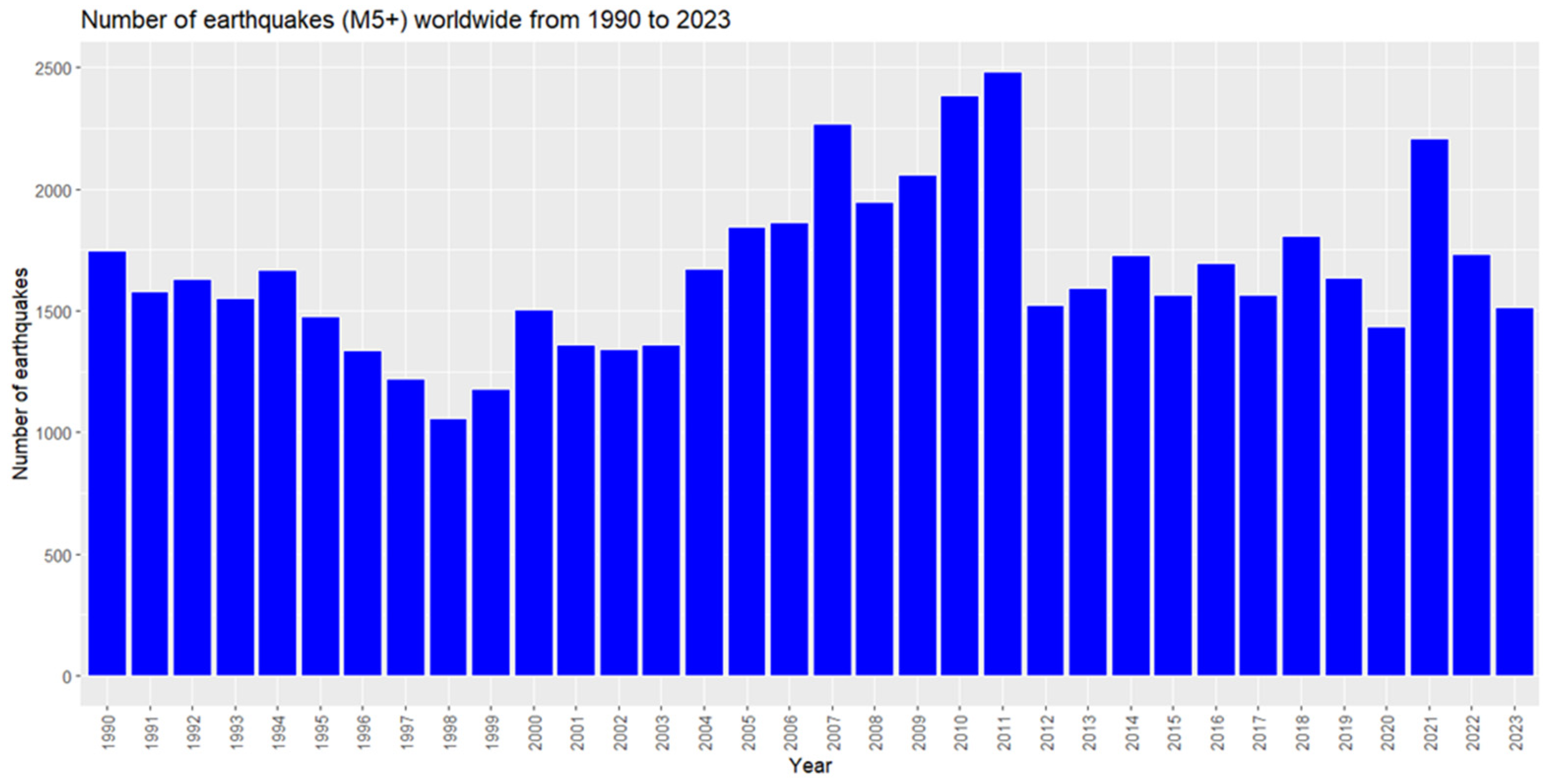
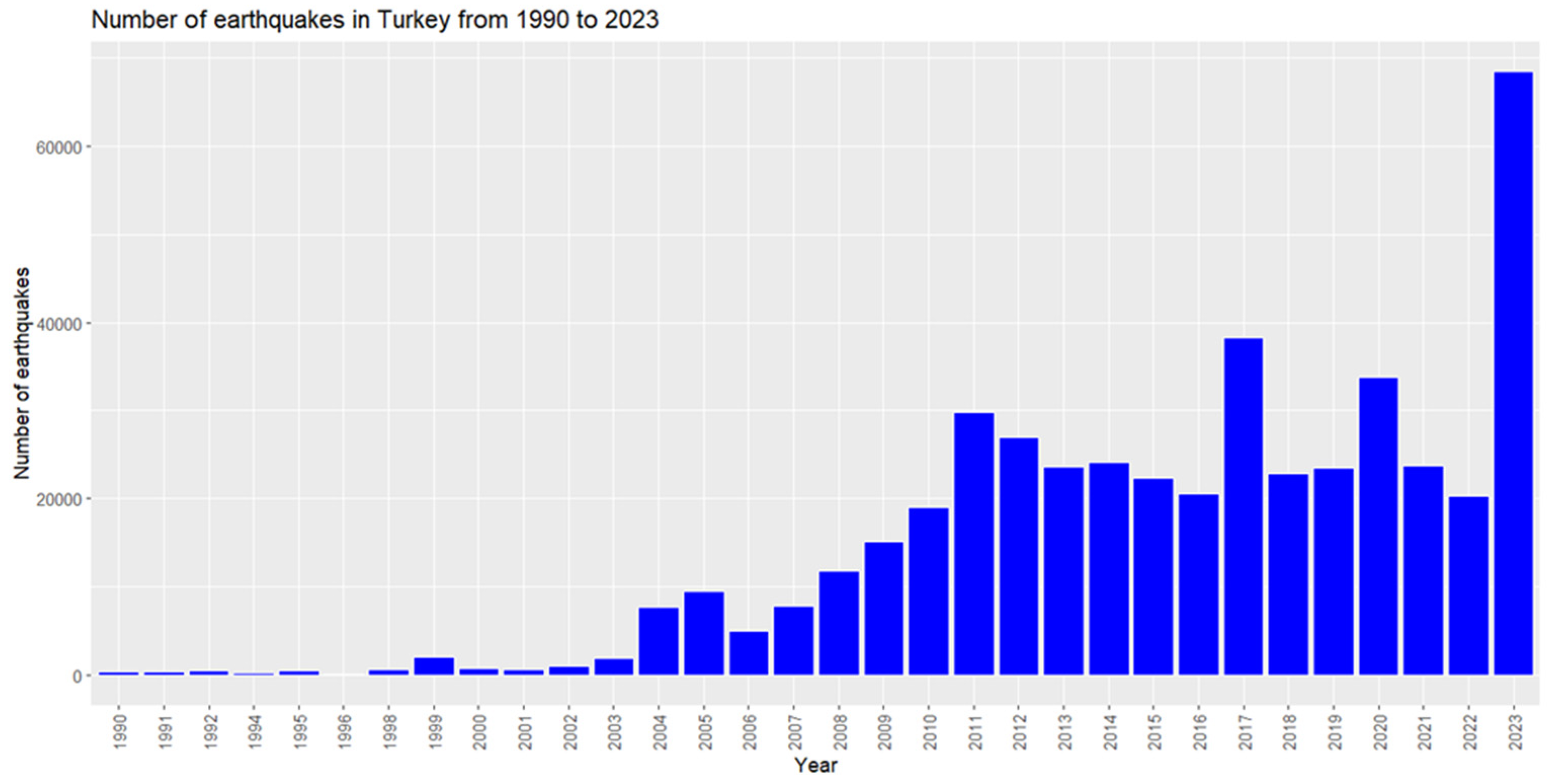
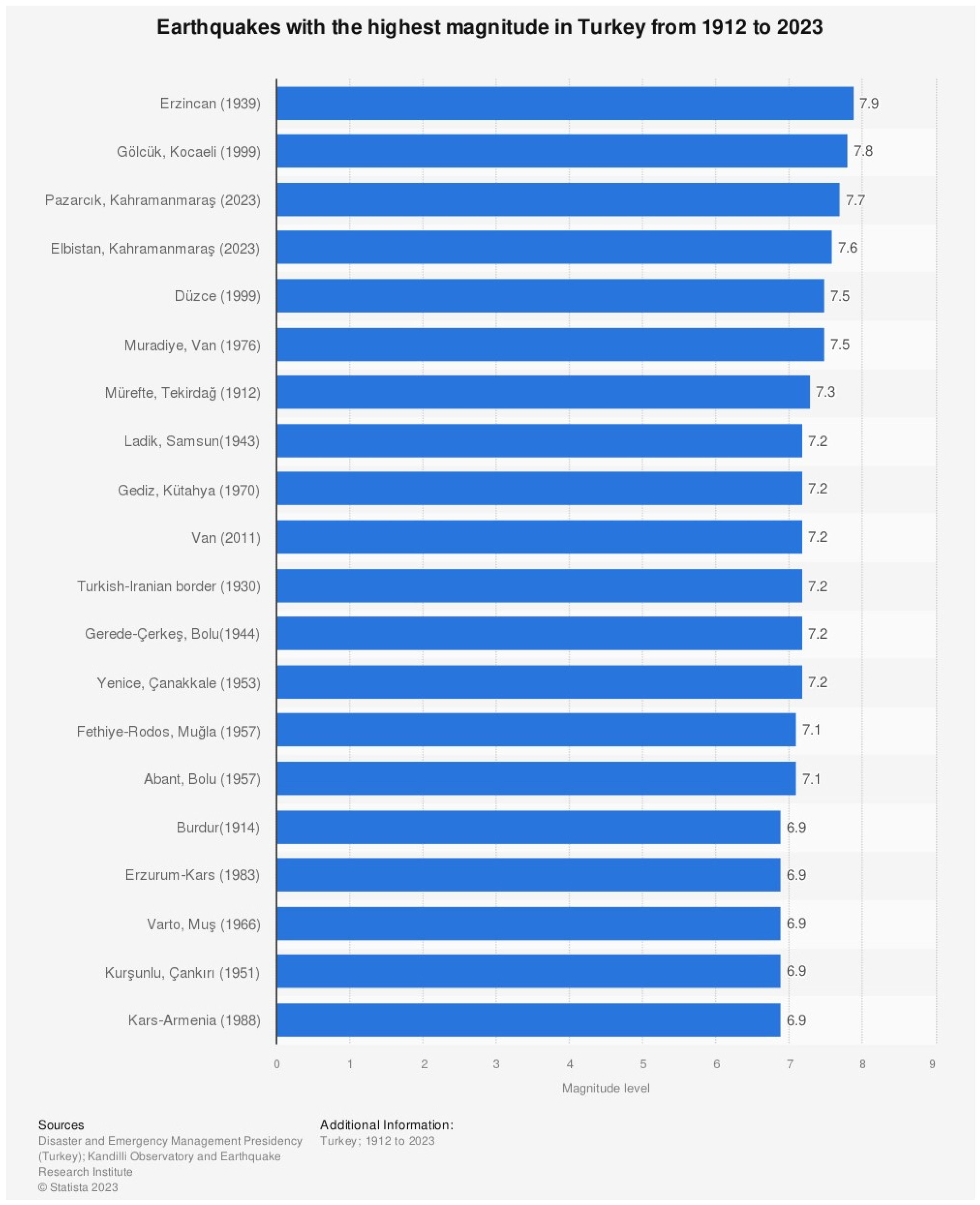
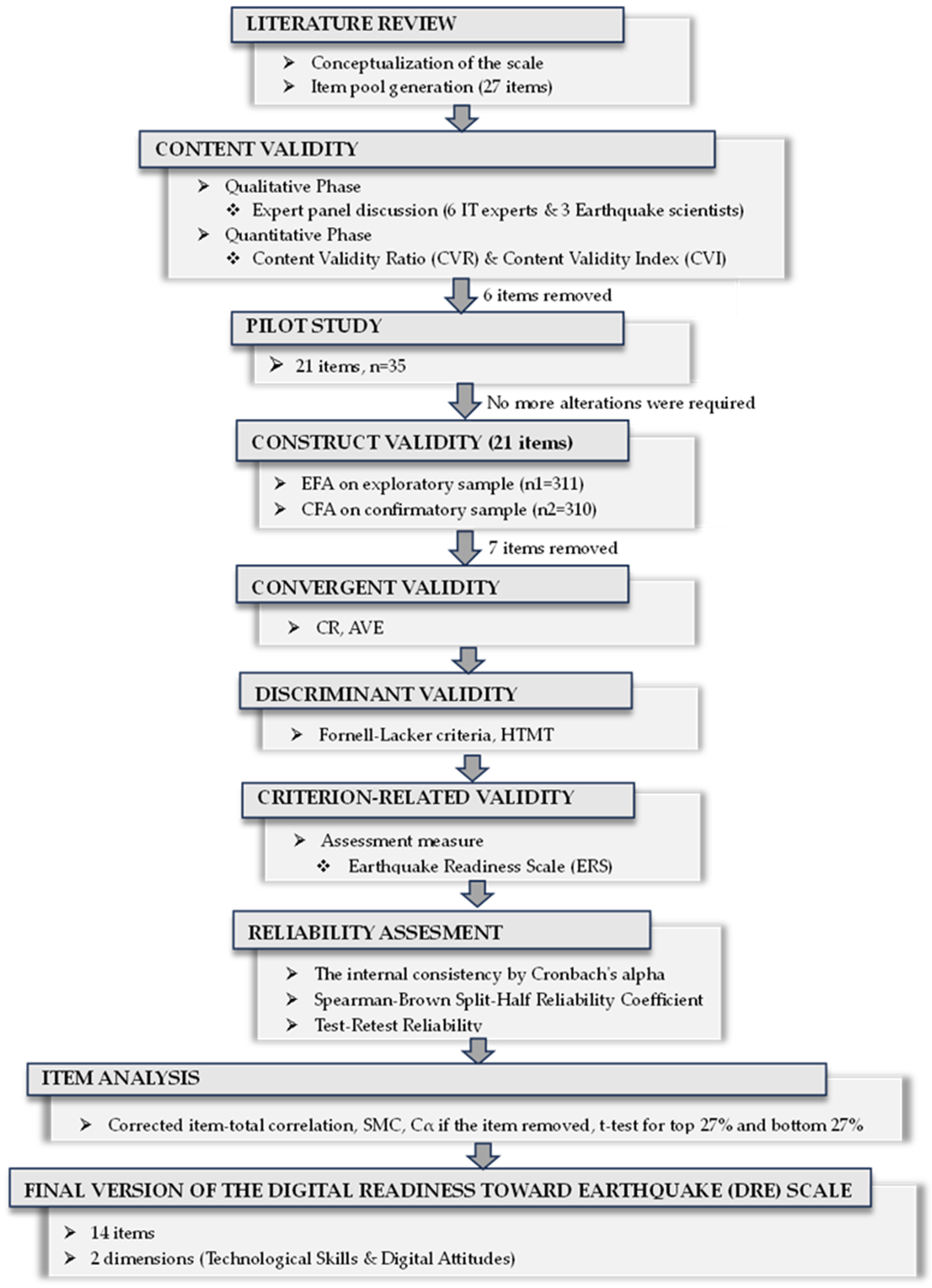
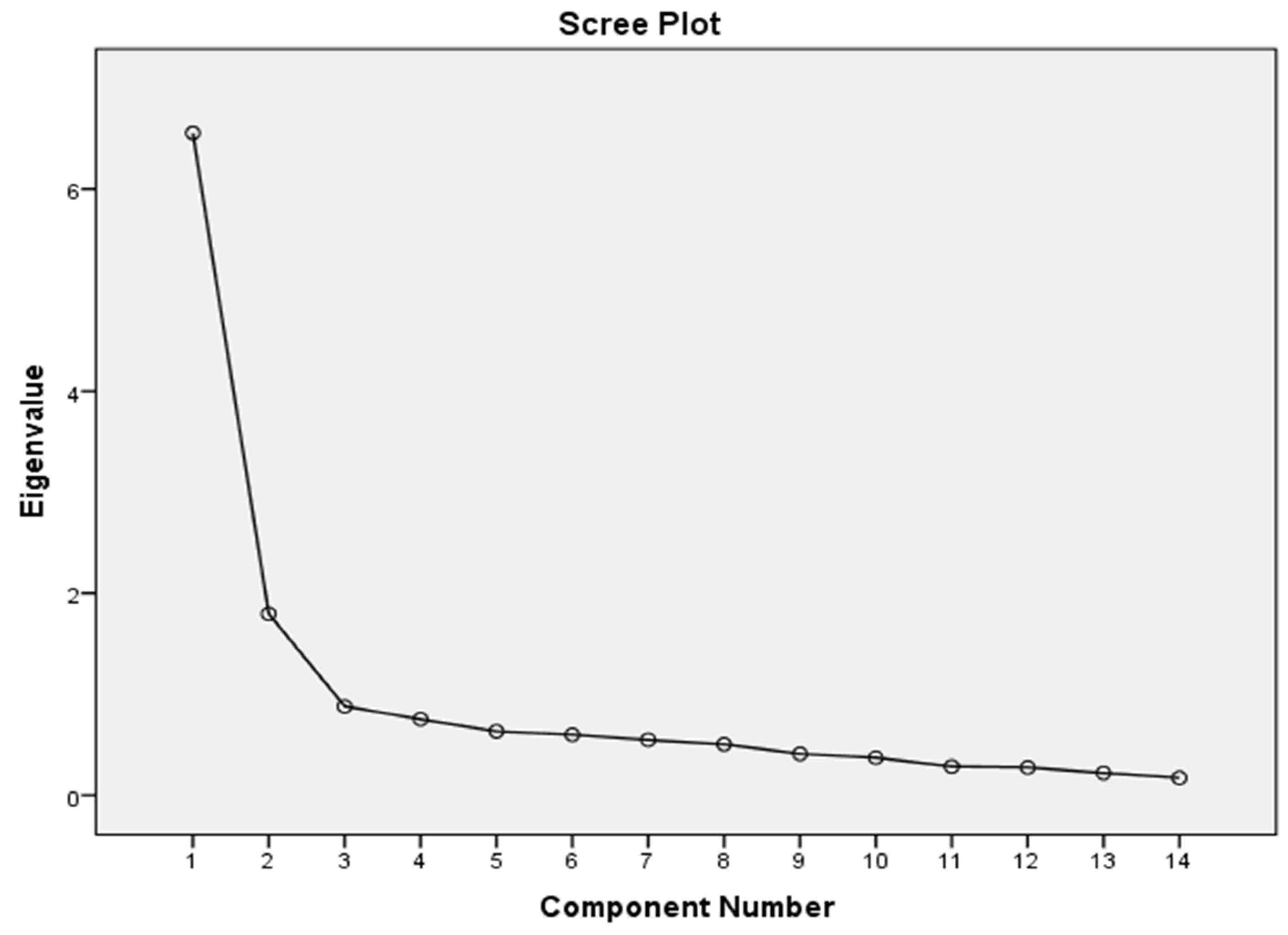
| Variable | f | % | |
|---|---|---|---|
| Gender | Female | 292 | 47 |
| Male | 329 | 53 | |
| Age | 18–25 | 82 | 13 |
| 26–29 | 127 | 20 | |
| 30–34 | 101 | 16 | |
| 35–39 | 92 | 15 | |
| 40–44 | 97 | 16 | |
| 45–49 | 50 | 8 | |
| 50–54 | 36 | 6 | |
| 55–59 | 18 | 3 | |
| 60+ | 18 | 3 | |
| Marital Status | Married | 259 | 42 |
| Single | 340 | 55 | |
| Other | 22 | 4 | |
| Country of residence | North Cyprus | 195 | 31 |
| Turkey | 426 | 69 | |
| Education level | High school | 27 | 4 |
| Undergraduate | 389 | 63 | |
| Master’s degree | 111 | 18 | |
| PhD | 94 | 15 | |
| Economic level | Poor | 30 | 5 |
| Middle | 335 | 54 | |
| Good | 256 | 41 | |
| Job | Student | 46 | 8 |
| Academician | 251 | 41 | |
| Teacher | 62 | 10 | |
| Engineer | 74 | 12 | |
| Architect | 45 | 7 | |
| Work-from-home professionals | 32 | 5 | |
| Nurse | 25 | 4 | |
| Medical doctor | 39 | 6 | |
| Advocate | 39 | 6 | |
| Not working | 8 | 1 | |
| Frequency of controlling notifications on mobile phone | Immediate | 208 | 34 |
| 1–2 times | 68 | 11 | |
| 3–5 times | 123 | 20 | |
| >5 | 219 | 35 | |
| None | 3 | 0 (0.4) | |
| Earthquake experience | Yes | 549 | 88 |
| No | 72 | 12 | |
| Item | Median (IQR) | Corrected Item–Total Correlation | |
|---|---|---|---|
| 3.79 (0.95) | 4 (1) | 0.654 |
| 3.91 (1.01) | 4 (1) | 0.748 |
| 3.56 (0.89) | 4 (1) | 0.569 |
| 3.38 (0.90) | 4 (1) | 0.688 |
| 3.85 (1.00) | 4 (2) | 0.448 |
| 3.76 (1.03) | 4 (1) | 0.439 |
| 3.95 (0.99) | 4 (1) | 0.598 |
| 3.82 (0.75) | 4 (1) | 0.601 |
| 3.77 (1.01) | 4 (1) | 0.458 |
| 3.57 (0.79) | 4 (1) | 0.674 |
| 3.64 (0.73) | 4 (1) | 0.557 |
| 3.81 (0.97) | 4 (1) | 0.689 |
| 3.58 (0.88) | 4 (1) | 0.530 |
| 3.67 (0.95) | 4 (1) | 0.481 |
| 3.49 (0.91) | 4 (1) | 0.623 |
| 3.39 (0.84) | 4 (1) | 0.471 |
| 3.43 (0.90) | 4 (1) | 0.509 |
| 3.59 (0.79) | 3 (1) | 0.605 |
| 3.66 (0.82) | 4 (1) | 0.499 |
| 3.87 (0.96) | 4 (1) | 0.637 |
| 3.75 (0.99) | 4 (1) | 0.683 |
| Item | CVR | I-CVI (Simplicity) | I-CVI (Ambiguity) | I-CVI (Clarity) | I-CVI (Relevance) | Interpretation |
|---|---|---|---|---|---|---|
| 1 | 1 | 1 | 1 | 1 | Remained |
| 1 | 1 | 1 | 1 | 1 | Remained |
| 0.8 | 0.9 | 0.9 | 1 | 1 | Remained |
| 1 | 1 | 1 | 1 | 1 | Remained |
| −0.6 | 0.1 | 0.2 | 0 | 0.1 | Eliminated |
| 1 | 1 | 1 | 1 | 1 | Remained |
| 0.8 | 0.9 | 0.9 | 1 | 1 | Remained |
| 0.3 | 0.1 | 0.1 | 0.2 | 0.1 | Eliminated |
| 1 | 1 | 1 | 1 | 1 | Remained |
| 1 | 0.9 | 1 | 1 | 1 | Remained |
| 0.8 | 0.9 | 1 | 1 | 1 | Remained |
| −0.8 | 0.1 | 0.1 | 0 | 0 | Eliminated |
| 1.00 | 0.9 | 1 | 1 | 1 | Remained |
| −1 | 0 | 0 | 0 | 0 | Eliminated |
| 0.8 | 0.8 | 0.9 | 0.9 | 0.9 | Remained |
| 1 | 0.9 | 1 | 1 | 1 | Remained |
| −1 | 0 | 0 | 0 | 0 | Eliminated |
| 1.00 | 1 | 1 | 1 | 1 | Remained |
| 1 | 1 | 1 | 1 | 1 | Remained |
| 1 | 1 | 0.89 | 1 | 1 | Remained |
| 0.8 | 0.9 | 1 | 1 | 1 | Remained |
| 1 | 1 | 1 | 1 | 1 | Remained |
| 1 | 1 | 1 | 1 | 1 | Remained |
| 1 | 1 | 1 | 0.9 | 1 | Remained |
| −0.1 | 0 | 0.1 | 0 | 0.1 | Eliminated |
| 1 | 1 | 1 | 1 | 1 | Remained |
| 1 | 1 | 1 | 0.9 | 1 | Remained |
| Item | |||
|---|---|---|---|
| Dimension 1: Technological Skills | |||
| DRE1 | I can use mobile applications related to earthquakes to my smartphone. | 0.817 | 0.681 |
| DRE2 | I can use mobile applications that can give advance warning of an approaching earthquake on my smartphone. | 0.817 | 0.637 |
| DRE3 | I can use mobile applications that make instant earthquake predictions to my smartphone. | 0.816 | 0.679 |
| DRE4 | I can use mobile applications that can give live earthquake information from all over the world to my smartphone. | 0.794 | 0.635 |
| DRE5 | I can use mobile applications that can be used in the event of an earthquake to my smartphone. | 0.791 | 0.664 |
| DRE6 | I can use mobile applications that can make loud noises (whistle, etc.) on my smartphone so that I can inform people around me of my location. | 0.762 | 0.559 |
| DRE7 | I can use mapping and GPS tools to find safe locations during an earthquake. | 0.746 | 0.565 |
| DRE8 | I can use earthquake-related mobile applications that work with Bluetooth connections instead of the Internet to my smartphone. | 0.692 | 0.517 |
| Dimension 2: Digital Attitudes | |||
| DRE9 | I often follow up-to-date information about earthquakes from official sites. | 0.900 | 0.685 |
| DRE10 | I often follow the instructions about earthquakes from official sites. | 0.873 | 0.680 |
| DRE11 | I always make sure that my smartphone is fully charged. | 0.681 | 0.545 |
| DRE12 | I regularly check the earthquake-related “do/don’t” lists on websites. | 0.650 | 0.590 |
| DRE13 | I always confirm the accuracy of the information shared about earthquakes on social media. | 0.612 | 0.429 |
| DRE14 | I often follow earthquake-related mobile applications from application stores (Apple Store, Google Play, Blackberry, etc.). | 0.562 | 0.486 |
| Measure | Value | Suggested Intervals | |
|---|---|---|---|
| Excellent Fit | Acceptable Fit | ||
| 141.056 | 2df < (df = 76) | ||
| 1.856 | |||
| RMSEA | 0.0654 | ||
| SRMR | 0.0389 | ||
| 0.9711 | 0.95 | ||
| 0.9759 | 0.90 | ||
| 0.9865 | 0.95 | ||
| 0.9887 | 0.90 | ||
| CFI | 0.9886 | 0.97 | 0.95 |
| GFI | 0.9385 | 0.95 | 0.90 |
| AGFI | 0.9296 | 0.90 | 0.85 |
| Dimension | CR | Cα | AVE |
|---|---|---|---|
| Technological Skills | 0.926 | 0.910 | 0.609 |
| Digital Attitudes | 0.865 | 0.837 | 0.525 |
| Dimension | Fornell–Larcker | HTMT | ||
|---|---|---|---|---|
| Technological Skills | Digital Attitudes | Technological Skills | Digital Attitudes | |
| Technological Skills | 0.780 | – | – | – |
| Digital Attitudes | 0.659 | 0.725 | 0.625 | – |
| Item | Median (IQR) | t (Top 27%—Bottom 27%) | |
|---|---|---|---|
| Dimension 1: Technological Skills | |||
| DRE1 | 3.86 (0.97) | 4 (2) | 13.533 *** |
| DRE2 | 3.90 (0.95) | 4 (1) | 12.258 *** |
| DRE3 | 3.62 (1.10) | 4 (1) | 15.067 *** |
| DRE4 | 3.59 (1.06) | 4 (1) | 12.452 *** |
| DRE5 | 3.93 (0.89) | 4 (1) | 10.705 *** |
| DRE6 | 3.92 (0.96) | 4 (1) | 14.989 *** |
| DRE7 | 3.81 (0.92) | 4 (1) | 9.922 *** |
| DRE8 | 3.48 (1.07) | 4 (1) | 10.544 *** |
| Dimension 2: Digital Attitudes | |||
| DRE9 | 3.76 (0.92) | 4 (1) | 9.340 *** |
| DRE10 | 3.71 (0.98) | 4 (1) | 12.599 *** |
| DRE11 | 3.25 (1.04) | 3 (1) | 9.687 *** |
| DRE12 | 3.53 (1.05) | 4 (1) | 14.809 *** |
| DRE13 | 3.77 (0.95) | 4 (1) | 12.610 *** |
| DRE14 | 3.08 (1.10) | 3 (2) | 9.136 *** |
| Item | Corrected Item–Total Correlation | SMC | Cα of the Removed Item |
|---|---|---|---|
| Dimension 1: Technological Skills | |||
| DRE1 | 0.707 | 0.718 | 0.901 |
| DRE2 | 0.665 | 0.607 | 0.902 |
| DRE3 | 0.708 | 0.673 | 0.900 |
| DRE4 | 0.680 | 0.606 | 0.901 |
| DRE5 | 0.708 | 0.693 | 0.901 |
| DRE6 | 0.615 | 0.532 | 0.904 |
| DRE7 | 0.637 | 0.510 | 0.903 |
| DRE8 | 0.617 | 0.441 | 0.904 |
| Dimension 2: Digital Attitudes | |||
| DRE9 | 0.495 | 0.522 | 0.908 |
| DRE10 | 0.532 | 0.545 | 0.907 |
| DRE11 | 0.574 | 0.437 | 0.906 |
| DRE12 | 0.640 | 0.575 | 0.903 |
| DRE13 | 0.492 | 0.359 | 0.908 |
| DRE14 | 0.584 | 0.490 | 0.906 |
Disclaimer/Publisher’s Note: The statements, opinions and data contained in all publications are solely those of the individual author(s) and contributor(s) and not of MDPI and/or the editor(s). MDPI and/or the editor(s) disclaim responsibility for any injury to people or property resulting from any ideas, methods, instructions or products referred to in the content. |
© 2023 by the authors. Licensee MDPI, Basel, Switzerland. This article is an open access article distributed under the terms and conditions of the Creative Commons Attribution (CC BY) license (https://creativecommons.org/licenses/by/4.0/).
Share and Cite
Sancar, N.; Cavus, N. A Novel Scale for Evaluating Digital Readiness toward Earthquakes: A Comprehensive Validity and Reliability Analysis. Sustainability 2024, 16, 252. https://doi.org/10.3390/su16010252
Sancar N, Cavus N. A Novel Scale for Evaluating Digital Readiness toward Earthquakes: A Comprehensive Validity and Reliability Analysis. Sustainability. 2024; 16(1):252. https://doi.org/10.3390/su16010252
Chicago/Turabian StyleSancar, Nuriye, and Nadire Cavus. 2024. "A Novel Scale for Evaluating Digital Readiness toward Earthquakes: A Comprehensive Validity and Reliability Analysis" Sustainability 16, no. 1: 252. https://doi.org/10.3390/su16010252
APA StyleSancar, N., & Cavus, N. (2024). A Novel Scale for Evaluating Digital Readiness toward Earthquakes: A Comprehensive Validity and Reliability Analysis. Sustainability, 16(1), 252. https://doi.org/10.3390/su16010252







